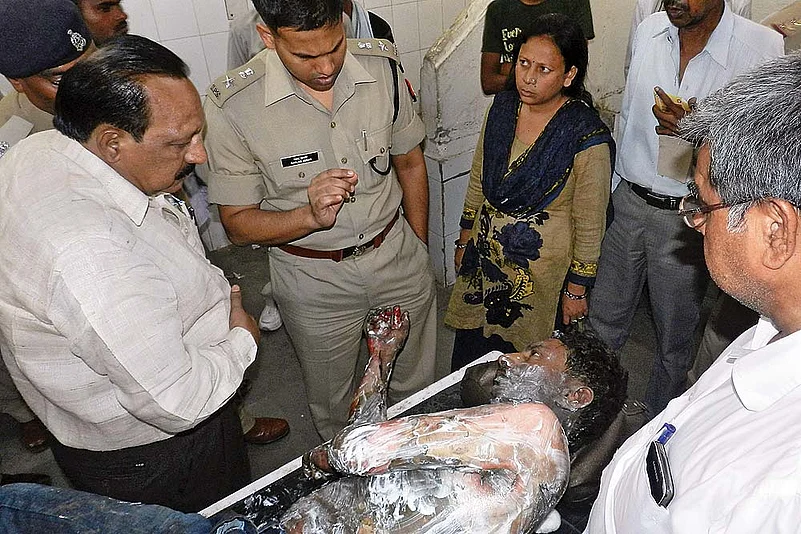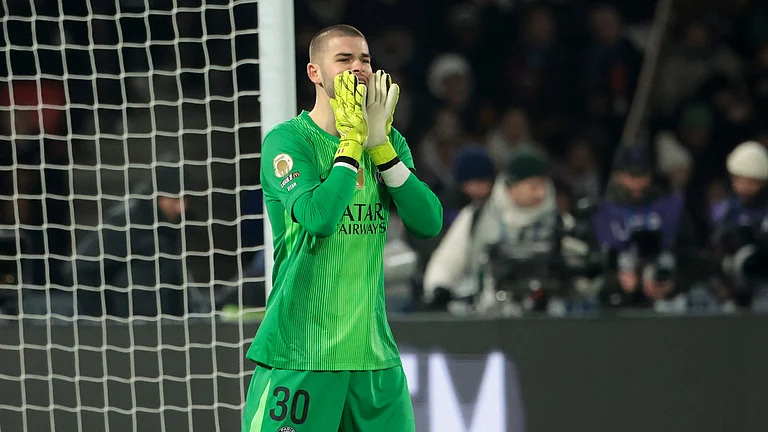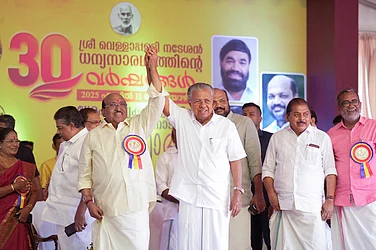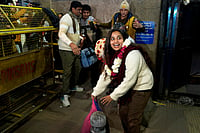Ground Down
- Uttar Pradesh: Jagendra Singh burnt in his own house ‘by policemen’ after he reported against the state’s PWD minister
- Madhya Pradesh: Sandeep Kothari abducted after reporting on illegal mining. Burnt body found in Maharashtra
- Uttar Pradesh: Haider Khan beaten, tied to a bike and dragged in Pilibhit after reporting on land-grabbing
- J&K: Javed Malik assaulted by security guards of a PDP minister after he protested against lewd remarks directed at his wife
- Punjab: Jasdeep Singh died in a freak accident (in 2013) after a truck rammed into car of local police chief
***
Sandeep Kothari, a journalist in his forties, was riding his motorcycle with a friend on the pillion in Katangi, in the Balaghat district of Madhya Pradesh, when a jeep rammed them from behind. The two men were beaten up; the assailants bundled Kothari into the jeep and left. The next day, June 22, his charred body was found near a railway track in neighbouring Maharashtra.
Kothari was a stringer (a freelancer who provides news inputs, usually from smaller towns and to more than one newspaper) for some Hindi newspapers. He had reported on illegal manganese mining in Balaghat and filed a complaint about it in court. He’d also exposed a chit-fund company. One of his last posts on Facebook, pledging to uphold India’s honour and sacrifices of martyrs till his last drop of blood, reads: “Azadi ki kabhi shaam nahi hone denge/ shahidon ki kurbani badnaam nahi hone denge/ Bachi ho jo ek boond bhi garam lahu ki/Tab tak Bharat mata ka aanchal nilaam nahi hone denge.” His sister says she had pleaded with him to give up journalism, dreading he’d be killed for his work.
But Madhya Pradesh police don’t see any link to his work. One official even alleged that Kothari was a ‘criminal’ and may have been killed by business rivals.
It’s an old story, repeating itself. The stringer personifies the journalist-as-individual, alone and with little money or organisational backing, striving to speak truth to power, puny but assertive, if a trifle shrill. He has appeared in cameo in stories, plays and films, usually the underdog, beaten into silence or killed like Kothari. He also appears as the wily machinator or pliable cog in the shadow world of small-town politicking, contract-mongering, motivated activism, even blackmail. Either way, he treads dangerous ground, as the flurry of attacks on stringers and small-time journalists in the last few weeks have shown. Two—Kothari and Jagendra Singh, of Shahjahanpur, UP—lost their lives; two got off with beatings.
The Committee for Protection of Journalists (CPJ), New York, puts India at the 13th position on its annual Impunity Index, highlighting murders of journalists in which killers aren’t brought to book. The CPJ says 35 journalists have been killed in India since 1992—on the lower side, for 24 journalists have been killed worldwide in 2015; but there’s a possibility that many more murders of Indian journalists have remained below the radar.
As the CPJ points out, the police is often a dodgy player. Though Jagendra Singh, who ran Shahjahanpur Samachar as a Facebook page, gave a dying declaration on camera naming the policemen who doused him with kerosene and set him afire, there are signs that they might walk free. This despite an ips officer, Amitabh Thakur, having recorded Singh’s statement in a voluntary capacity. Thakur says that should serve as a dying declaration and as admissible evidence, but the investigating officers have ignored it. Even the media seems to be losing interest. The policemen have since been suspended. But no one seems to be tracking why they’d gone to Jagendra’s house and how he could have run up to his roof when they were there and set himself aflame, as they say he did. Some say the compensation and jobs offered to the family by chief minister Akhilesh Yadav are an attempt to cover up the involvement of state minister Ram Murti Verma, against whom Jagendra had been running a campaign. He had also lodged an FIR alleging assault by Verma’s goons.
After Jagendra’s death on June 8, instead of focusing on investigations, two cops in Lucknow systematically slandered him. They called him a “blackmailer in the garb of a journalist”, said he was “playing into the hands of the minister’s adversaries”. They insinuated that he was in an extramarital relationship with a woman, an anganwadi worker who Jagendra had alleged was raped by the minister.

Govt deaf Jagendra’s family wants a CBI probe
There was no surprise, therefore, when forensic experts submitted a report on June 22 accusing Jagendra of setting himself ablaze. No one was surprised either when the woman—who had gone on record to accuse the minister of molestation and rape and said the cops had burnt Jagendra alive at the minister’s behest—recanted and recorded a new statement before a magistrate that the journalist had set himself on fire.
Shivpal Yadav, the chief minister’s uncle and arguably Uttar Pradesh’s most powerful minister, has made it clear there could be no action against Verma unless something “substantive” is found against him and his men. That seems unlikely, for the police seem headed towards preparing a report that the minister did no wrong and Jagendra was to blame for what happened. The family’s demand for a CBI probe has been overlooked. Some ministers say that in response to a popular demand for a CBI probe, the government had sacked a minister (Raja Bhaiyya), but eventually he’d got a clean chit and was reinducted. The CBI had accepted the findings of the state police in the infamous rape and hanging of two girls in Badaun too, they say, explaining the futility of rushing to the CBI.
Despite the danger and suspicions arrayed against stringers, it cannot be denied that there are some who tread the straight and narrow. Rajesh Jhadi, in Bijapur, Chhattisgarh, practises what might be called pro bono journalism. There is no payment for any of the stories he files. Instead, he has to collect ads and is paid a commission for these efforts. If the advertisers default on payment, he bears the losses.
Many such reporters are not stringers by choice though. In some cases, though, it is their passion that works like an addiction. Manoj Dutt, of Latihar, Chhattisgarh, sells videos to TV channels for as little as Rs 500 and waits for weeks for the payment. Often, when the videos don’t get broadcast or the reports aren’t published, stringers like Dutt don’t get paid anything. Many augment their income by using their symbiotic relationship with the district administration to get works contracts for their friends, with small commissions as their slice of the pie.
Sambeet Silu Pradhan, of Sonua, a town in Jharkhand, juggles the roles of news-gatherer, writer, newspaper vendor and ad and payment collector. He was keen on a salaried job with a Hindi daily he provides news to. But although the stories he has broken—of human trafficking, rights violations, a rape accused being let off with a fine of Rs 500 and a goat—a job has eluded him so far.
In the Jagendra Singh case, the Supreme Court has asked the Press Council of India for a response. Perhaps it might be the beginning of the recognition of these lone sentinels.
By Ushinor Majumdar in Delhi, Sharat Pradhan in Lucknow


























